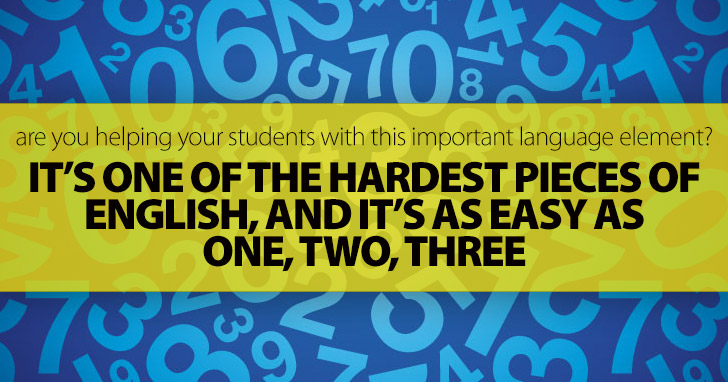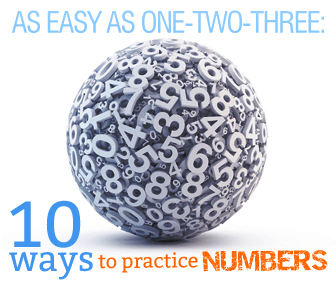Itís One of the Hardest Pieces of English, and Itís As Easy As One, Two, Three: Are You Helping Your Students with This Important Language Element?


Because numbers are such an abstract concept, most people tend to revert to their first language when using them. Still, numbers are worth practicing and should be a part of most ESL classes. These fun classroom activities will challenge your students to use English words for numbers, sometimes in conversation and sometimes in writing, and will help solidify English numbers in their minds.
“Do you have any fours?” You may hear this question frequently if you allow your students to play Go Fish as part of their number practice. To make the game more challenging and give your students more numbers practice, use two decks of cards for around eight students for one game. Require that a player must have all eight matching cards before he can claim them for his own. Your students will laugh at how confusing the game can become with sets of cards passing back and forth between all the players!
A deck of cards can entertain your students with more than Go Fish. Play the game Twenty-Four in groups between two and four players. Each round of a four-player game, each player lays one card down. (Two players lay two cards each. Three players rotate who lays down the extra card.) Each card has the number value on the card, with aces counting as one and face cards counting as ten. The players race to make a mathematical equation using the four numbers so the answer is twenty-four. When someone has an answer, he taps the table and shares it with his opponents. Though most often used to practice math skills, requiring your students to explain their math using English words for numbers will give them practice with their language skills, too.
Another card game that gives your students a chance to practice numbers in English is Bologna. To play, groups of four to six students divide a deck of cards between them. Starting with the first person, he places one or more cards into the center of the table and announces the quantity of two’s that he is placing there, face down. The second player must announce how many three’s she is putting in the center of the table, face down. Play continues around the circle with each player announcing a quantity of cards ordered from three to ace and then starting back at two. In reality, players may or may not lay down the quantity or denomination of cards they announce. The key to the game is bluffing and knowing when others are doing the same. At any point during play, any player may call “Bologna!” if she thinks or knows another student is lying. If the player was lying and did not put down the cards she announced, she must take all the cards in the center. If that player was telling the truth, the player who called bologna must take the entire pile. Play continues until someone is out of cards and wins the game.
Review with your students all the personal information that contains numbers. Address, phone number, birthday and even email address often contain numbers. Have students work in groups of four or five to create a map of where their classmates live. Give your students some time to interact and collect the addresses of each of their classmates. Then, have groups of students make a map of the town and nearby area to show where each person lives. You will need to have map resources available to your students for this activity. Post the maps around the classroom once they are finished!
To challenge your students with longer numbers, have them create a timeline of the significant events of their lives. If you can, get a long roll of paper and encourage students to include photographs or illustrations of their significant events. To make sure your class is practicing numbers in English, have them write out the years rather than using numerals on their timelines.
Whether you realize it or not, tracking the weather is a great way for ESL students to use numbers. Take some time each day to access basic weather information – temperature, dew point, humidity and barometric pressure – and talk about it at the start of the school day. You may want your students to keep a record of the weather patterns. If not, encourage discussion that includes temperatures and other weather numbers, and make sure your students are using numbers during the discussion.
With a classroom market place, your students can practice buying, selling and bargaining with numbers in English. Start by having each person imagine a product they might want to sell at the classroom marketplace. It is easier to make the items hypothetical, but you may choose to have your students create actual items from art supplies you have in the classroom. Then, make copies of special classroom dollars and give each student ten dollars to spend in the market. Let your students haggle (explain this concept before opening the market and do not allow anyone to purchase anything without haggling) and then see what everyone ends up by the end of the activity. Who made the most money? Who got the best items?
New math is not as new as it used to be, but challenging your students to do mental math problems will get them using numbers in English. Give your students a chance to do some simple mental math problems, and then let the real challenge begin. Using a spelling bee format, ask your students to do increasingly difficult mathematical equations without using paper. If a student gets one wrong, he sits down. The last one standing is the Mental Math champion!
Class surveys are another way your ESL students can practice using numbers in English. As a class, make a list of demographic or statistical categories that might apply to your students. For example, how many students have dogs, how many have more than one sibling, how many have grandparents still living, etc. Brainstorm a large list, and then ask each student to choose five questions he will ask each of his classmates. Give your students time to interview one another, and then have each person write a sentence for each of his categories. For each question, the student must write a statement using words and not numerals to represent the answers. Also see ‘Go Ahead, Ask: How to Use Surveys to Teach English’.
Many proverbs and idioms contain numbers. Alex Case compiled this list, which you can use in your ESL class. Challenge students to guess which number completes each phrase and then match that phrase to the correct definition.
If you have additional number review exercises that have worked with your class, share them in the comments below so everyone can see how great they work!